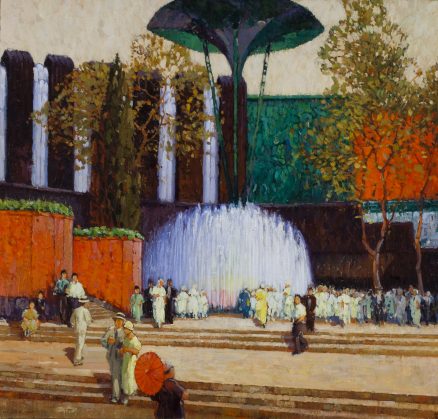The Fountain, Electrical Building
, 1933Oil on canvas, 31⅛ by 33⅛ inches
- Categories
- Chicago places & people
- Events
- Landscapes
- Zoom in on Artwork
- Print Page
- Email Page to Friend
Positioning the viewer on the plaza created by the horseshoe form of the Electrical Building at Chicago’s Century of Progress exposition, Frederic M. Grant’s The Fountain, Electrical Building takes a close-up perspective on the massive building, in contrast to the distant views painted by Rudolph Ingerle and Otto Koch. On the left is a section of the curved back-and-white striated wall whose tube lights created a “waterfall” of light at night, and to the right rises a monumental male figure representing atomic energy, one of the façade’s two forty-foot-high bas-relief sculptures designed by architect Raymond Hood. The building’s contrasting colors form a dramatic backdrop for a crowd of visitors, including a well-dressed couple, a woman under a bright red parasol, and throngs of children dressed in summertime white. Dominating the scene is the so-called Morning Glory Fountain at the plaza’s center. At night its towering trumpet-shaped canopy of chromium-plated hand-hammered copper reflected colored floodlights projected through the cascading water, enhancing their glow. Noted as a “decorative” painter, Grant treated the scene with his characteristic all-over texturing of the paint surface and firm delineation of forms, within a balanced, nearly square format.
The Electrical Building’s futuristic displays of light were most impressive at night, but Grant elected to show it in daytime to highlight the brilliant tints of the building’s exterior. The exposition was innovative throughout in its large-scale use of color as an integral part of its architectural plan. Famed as a colorist, Grant seemed particularly suited to the task of recording its striking hues. The Fountain, Electrical Building was one of a group of twenty-one views of the exposition he painted in 1933, the first of its two consecutive seasons. Grant worked on the paintings in his studio from watercolor studies executed on site, and he gave many of the canvases titles that reflect their dominant color. Both the studies and the finished paintings were exhibited in a well-received solo show at Anderson Galleries in Chicago in the winter of 1934. The conservative Grant was not the only artist to paint the fair, but even in the opinion of critic Clarence J. Bulliet, a champion of modernism, he was the most successful: “the one painter who caught and fixed as a genuine ‘art expression’ the jazz-made riot of color,” Grant conveyed in his paintings “the ‘emotional content’ of the exposition, along with the ocular.”i
Wendy Greenhouse, PhD
Donated by M. Christine Schwartz to the Newberry Library, Chicago, Illinois, in 2021
i C. J. Bulliet, “Artists of Chicago Past and Present. No. 62: Frederic Milton Grant,” Chicago Daily News, Apr. 25, 1936.
